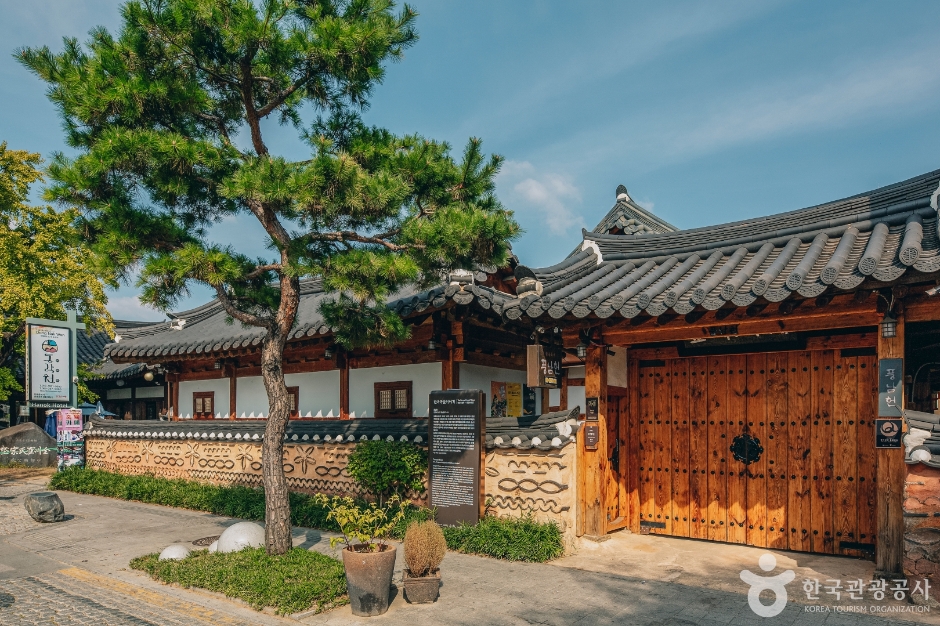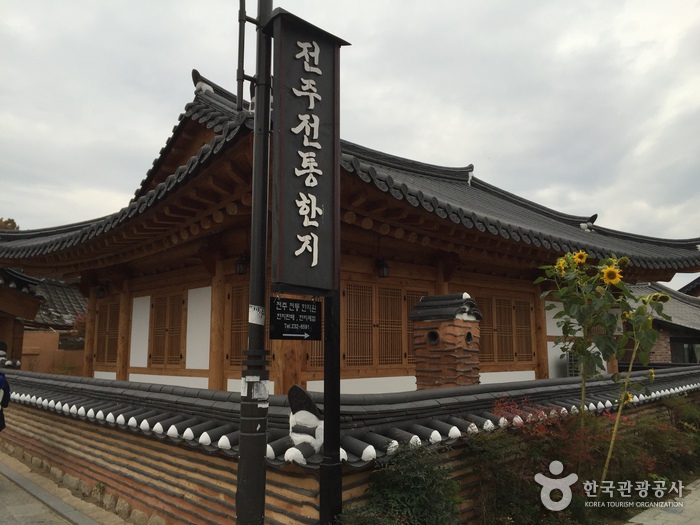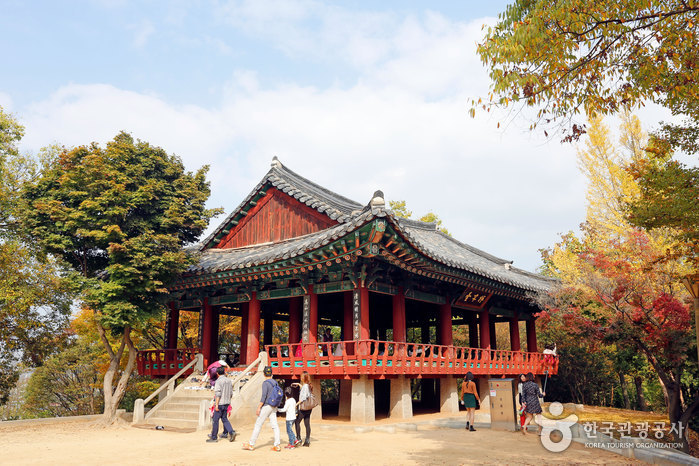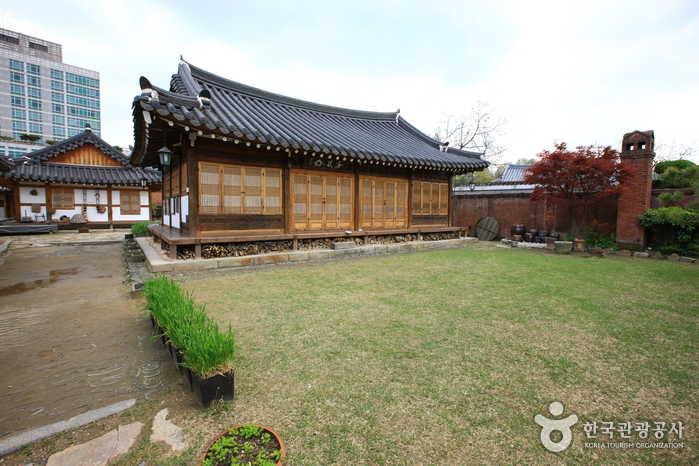PoongNamheon (풍남헌)
700.9M 8159 2024-08-05
35 , Eunhaeng-ro, Wansan-gu, Jeonju-si, Jeonbuk-do
+82-63-286-7673, +82-10-2757-7673
Pungnamheon is a hanok stay in a traditional nobleman's house in Jeonju, Jeollabuk-do. Next to the house stands a 600-year-old ginkgo tree, the guardian spirit of Jeonju Hanok Village. Two unusual features of this hanok is that there is no wood-floored hall or daecheong, and the toenmaru wooden porch is extra wide, and has a window. The floors are finished with laquered hanji (Korean paper), and the roof tiles were made in Goryeong. Old folding screens and Korean paintings complete the atmosphere of a traditional yangbang house. Guests have a chance to taste wild green tea gathered and made by the owner.
GaEunChae2 [Korea Quality] / 가은채2 [한국관광 품질인증]
706.0M 204 2024-04-07
100-20 , Hanji-gil, Wansan-gu, Jeonju-si, Jeonbuk-do
+82-63-284-7775, +82-10-6335-5267
Gaeunchae 2 is the sister hanok of Gaeunchae in Jeonju Hanok Village, Jeollabuk-do. It’s a traditional red clay-walled hanok with ondol underfloor heating, exposed roof beams and hanji wallpaper and flooring - creating a beautiful and distinctive hanok interior. It has a small hallway which is good for storing luggage or just to sit and chat. In the garden are sculpted stone lanterns and tigers. Local attractions such as Jeondong Cathedral and Gyeonggijeon Shrine are a short walk away.
Blueboat guest house Jeonju [Korea Quality] / 블루보트게스트하우스 전주점 [한국관광 품질인증]
722.8M 764 2024-04-07
75 , Chunggyeong-ro, Wansan-gu, Jeonju-si, Jeonbuk-do
+82-10-6545-9049
The Blue Boat Guesthouse in Gyeongwon-dong, Jeonju, Jeollabuk-do, makes a stylish impression and is visited by many young travelers. Gyeonggijeon shrine, Jeondong Cathedral, Jeonju Hanok Village, and Nammun Market are all around10 minutes’ walk away. All rooms have neat iron beds, with shared bathrooms and kitchens. There is a TV in the kitchen, so residents can gather there to share information and chat.
Jeonju Traditional Hanji Center (전주전통한지원)
724.0M 12430 2024-04-07
100-10, Hanji-gil, Wansan-gu, Jeonju-si, Jeonbuk-do
+82-10-8959-7757
Jeonju has been a major producer of quality hanji paper for more than a thousand years. In keeping with this proud tradition, the Jeonju Traditional Hanji Center aims to preserve traditional paper-making techniques and become a mainstay in the hanji industry. More than 80 percent of the paper produced at the center is exported to Japan while the rest is used in Korea. The center produces, exhibits, and sells hanji used for calligraphy, Oriental paintings, and crafts, as well as special “yellow earth” wallpaper hanji and charcoal hanji, said to provide certain health benefits. Visitors can also sign up for crafting classes, including first-hand experience at making hanji, imprinting patterns and drying the paper.
Seoro[Korea Quality] / 서로[한국관광 품질인증]
724.2M 8657 2024-04-07
100-12 , Hanji-gil, Wansan-gu, Jeonju-si, Jeonbuk-do
+82-10-4033-2610
Seoro is a traditional hanok accommodation located in the Jeonju Hanok Village that offers guests a peaceful and quiet atmosphere. There are 10 different types of rooms, including ondol-type rooms, duplex-type rooms, and pension-type rooms. Traditional Korean red clay and ondol floors are installed in each room using the traditional Korea gudeul method (underfloor heating system), and the finest Korean wonanggeumchim (lovebird bedding) are provided. At night, you can rest under the stars on the large yard or toenmaru (narrow wooden porch).
Hanok Stay Eosahwa [Korea Quality]한옥 어사화[한국관광 품질인증]
728.1M 1 2024-04-07
106-1 , Hanji-gil, Wansan-gu, Jeonju-si, Jeonbuk-do
+82-507-1383-3344
Eosahwa Hanok Stay, which stands in the center of Jeonju Hanok Village, Jeollabuk-do, was originally built as the residence of the Jeonju police chief; it’s unusually high for a hanok and faces south. A bed has been provided for guests unfamiliar with ondol sleeping, and two rather small rooms were put together to make a larger bedroom and living room. A healthy and delicious breakfast is provided. All the sights of Jeonju Hanok Village are nearby.
Dong Nak Won [Korea Quality] / 동락원 [한국관광 품질인증]
733.2M 219 2024-04-07
33-6 , Eunhaeng-ro, Wansan-gu, Jeonju-si, Jeonbuk-do
+82-63-287-9300, +82-10-4951-9300
Dongnagwon is a hanok hotel in Jeonju Hanok Village, Jeollabuk-do. It was built as a memorial hall for the missionary William Junkin, who founded a school mission in Jeonju in 1895. Now refurbished as a hotel and venue for traditional performances, wedding ceremonies and seminars, visitors will find old-style interiors with antique furniture and folding screens. Guests can play traditional games in the yard, and there is a red clay room to relieve the fatigue of travel, free of charge. Mountain bikes can be borrowed to ride around the Hanok Village or on the banks of the Jeonjucheon Stream.
Wonderbra - Jeonju Branch [Tax Refund Shop] (원더브라 전주점)
741.1M 0 2024-04-22
24, Jeonjugaeksa 4-gil, Wansan-gu, Jeonju-si, Jeollabuk-do
-
Omokdae and Imokdae Historic Sites (오목대와 이목대)
743.8M 27949 2024-04-07
55 Girin-daero, Wansan-gu, Jeonju-si, Jeonbuk-do
+82-63-281-2114
Omokdae Historic Site is located on top of a steep hill and is one of the places where Yi Seong-gye, who later became King Taejo, the first king of the Joseon dynasty, stopped to celebrate his victory on his way home from a war against the Japanese army at Unbong Peak of Hwangsan Mountain. Across the bridge from Omokdae is Imokdae Historic Site, situated at the foot of Seungamsan Mountain. Approximately 80 meters downhill from Imokdae are memorial stones and a building where Mokjo, the great-great-grandfather of King Taejo, once used to live. The engraved letters on the stones are the handwritings of Emperor Gojong. Mokjo moved to Hamgyeongdo as a result of a dispute with the then minister of Jeonju, an incident which King Taejo believed to have laid the foundation for him to shape the Joseon dynasty.
Dongnagwon House (동락원)
744.9M 13096 2024-04-07
33-6, Eunhaeng-ro, Wansan-gu, Jeonju-si, Jeonbuk-do
+82-63-285-3490
The Dongnagwon House in Jeonju Hanok Village provides a getaway to experience hanok stay and traditional Korean life. Affiliated with Jeonju Kijeon College, Dongnagwon is also a memorial hall dedicated to W. M. Junkin, who came to Korea as a missionary from the South Presbyterian Church of the United States in 1892. Dongnagwon is a reproduction of the old hanok houses in Jeonju from the time when W. M. Junkin was doing his missionary work in the area. It is
comprised of three buildings: Anchae (main hall), Sarangchae (guest house), and Haengnangchae (servants’ quarters).
Visitors to Dongnagwon can learn and experience traditional Korean culture such as music, crafts, and dance while inhabiting traditional lodging. In addition to providing accommodation for individual guests, Dongnagwon is also used for group accommodations or activities such as seminars, conferences, and family events. For groups of 30 or more, it is possible to rent out the entire venue (in addition to all facilities, including Seungdokdang, Seunghwadang, Cheongyuje, and the front yard).


![Seoro[Korea Quality] / 서로[한국관광 품질인증]](http://tong.visitkorea.or.kr/cms/resource/38/2814938_image2_1.jpg)
![Dong Nak Won [Korea Quality] / 동락원 [한국관광 품질인증]](http://tong.visitkorea.or.kr/cms/resource/16/2595016_image2_1.jpg)



 English
English
 한국어
한국어 日本語
日本語 中文(简体)
中文(简体) Deutsch
Deutsch Français
Français Español
Español Русский
Русский